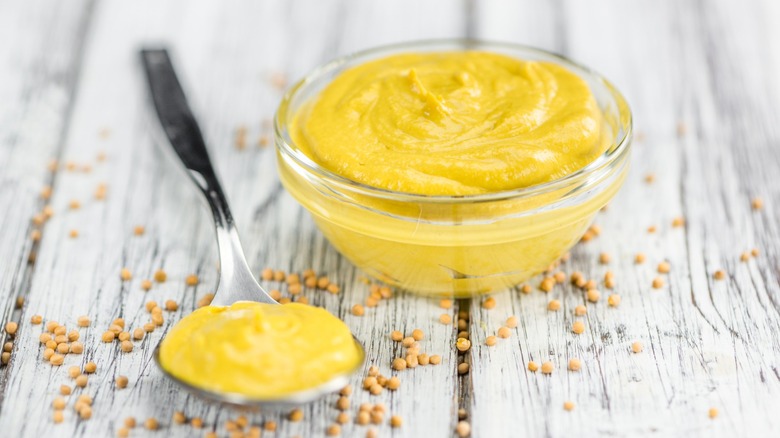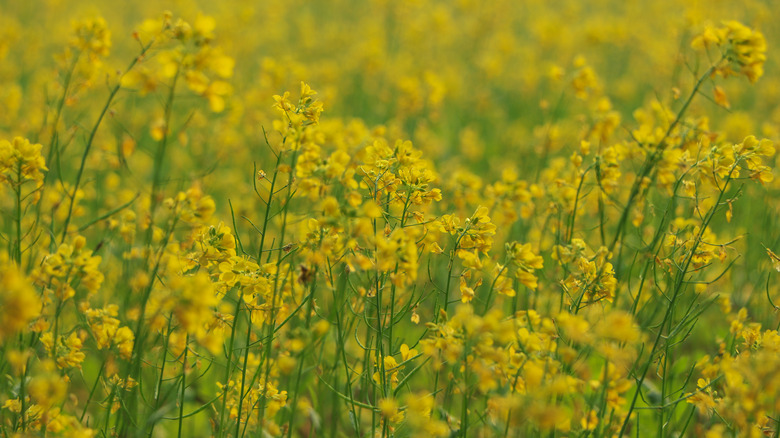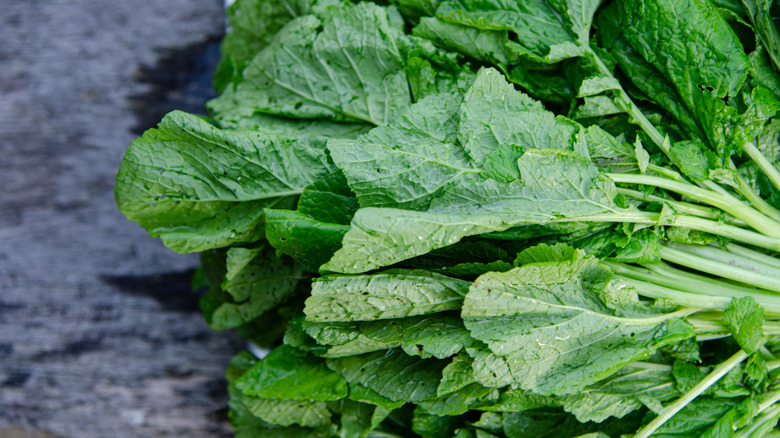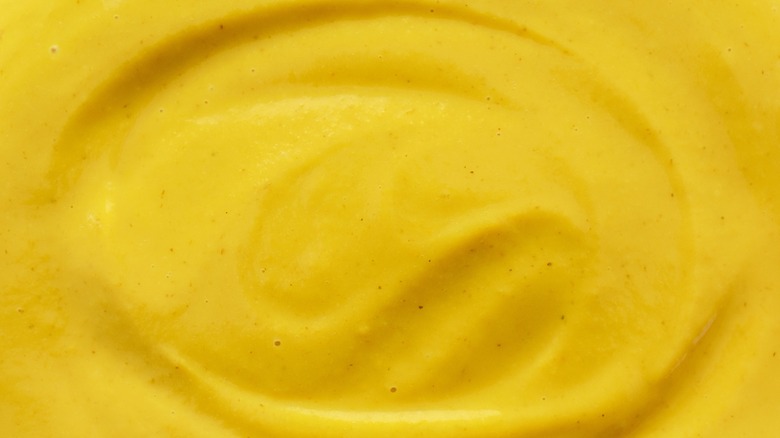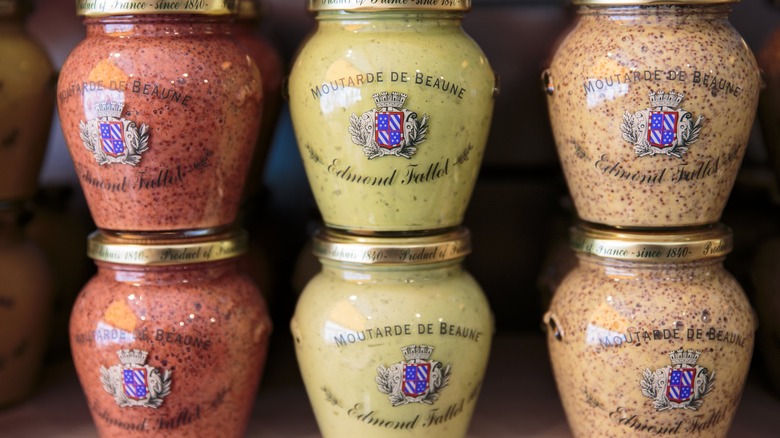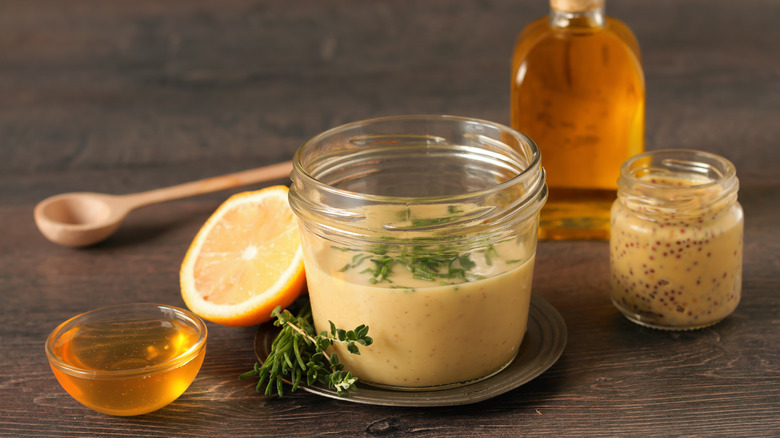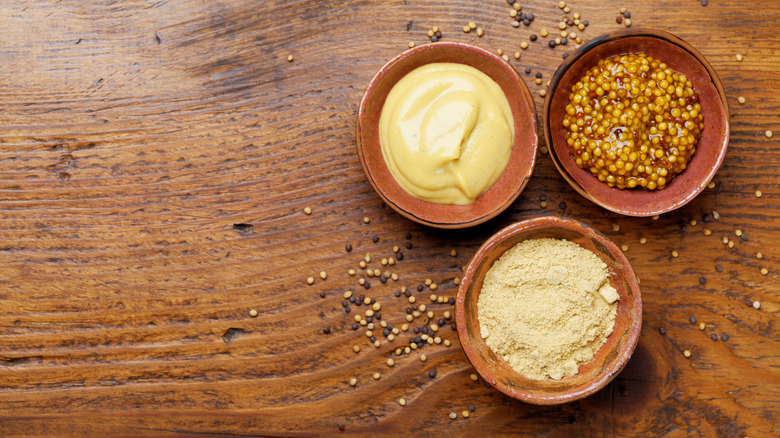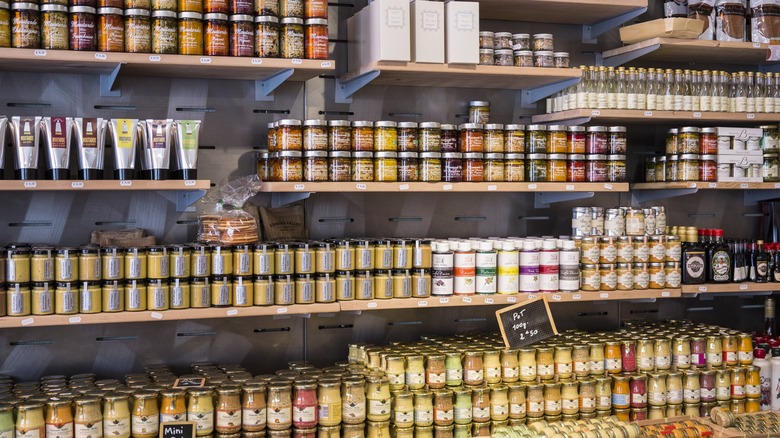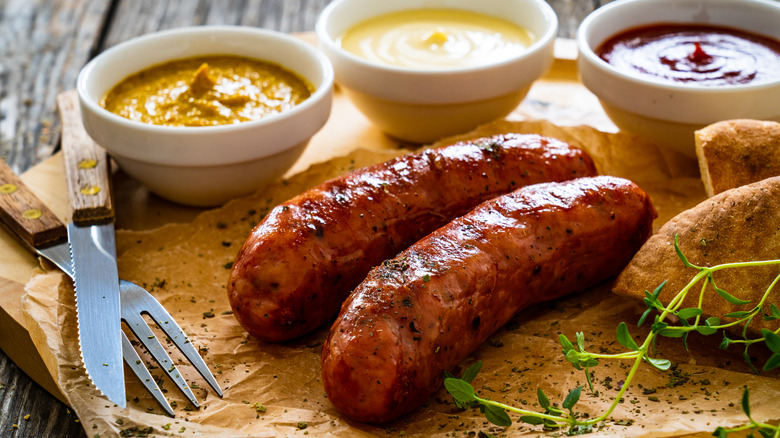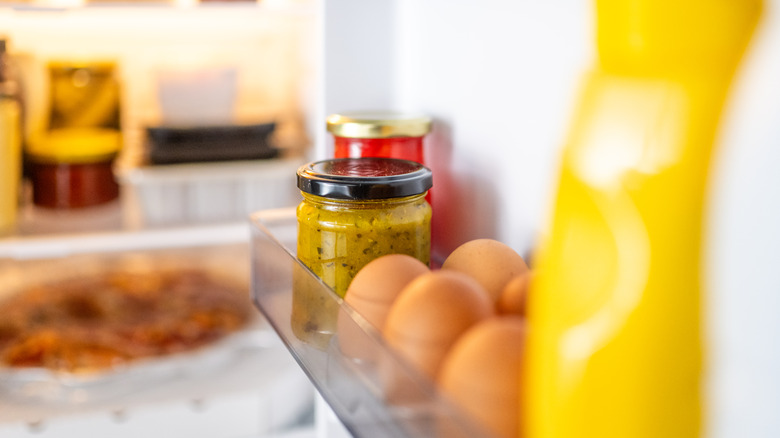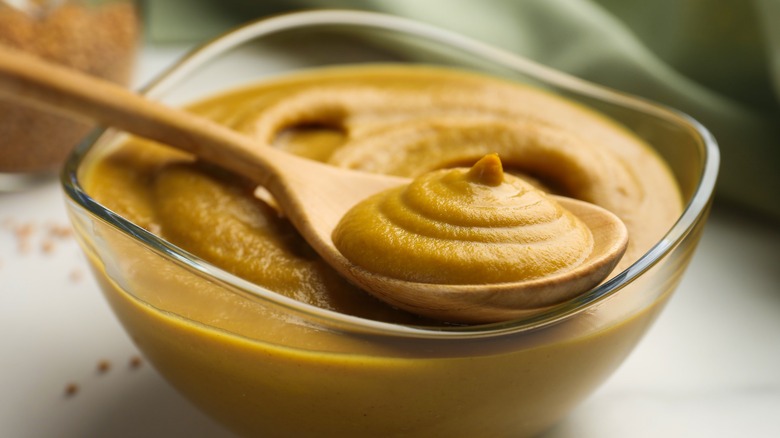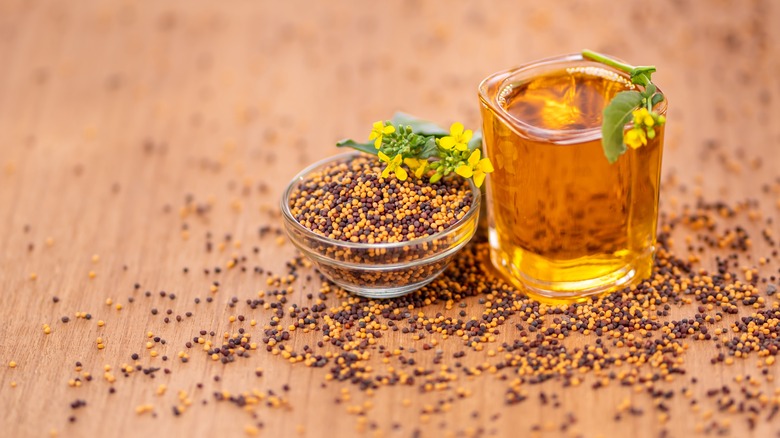Everything You Wanted To Know About Mustard But Were Too Afraid To Ask
Mustard has a sharp, tangy flavor unlike any other. This condiment is the best thing to perk up a sandwich, as it pairs well with most meats, vegetables, and cheeses. You probably have more than one type of mustard in your fridge right now. There's even a National Mustard Museum in Wisconsin!
There's mustard in most fast food restaurants, ballparks, and movie theater concession stands in the United States, but mustard is more than a beloved American condiment. It has been used all over the world for centuries, both in culinary and medicinal applications. Maybe you love the yellow stuff, or maybe you don't. But whether or not you reach for the mustard when you're fixing your hot dog, you may have some questions about this unique and versatile food. So what is it, what's all the fuss about, and how do we use it today? Read on to find out.
What is mustard and where does it come from?
Although it's often presented to us in the form of a sauce or a spread, mustard is actually a plant. The mustard plant — identified by its many small, yellow flowers – is part of the Brassicaceae family, which includes cabbage, broccoli, Brussels sprouts, and rapeseed (where canola oil comes from). Both the leaves and seeds of the mustard plant are edible. To make the condiment we know as prepared mustard, the seeds of the mustard plant are combined with water, vinegar, lemon juice, or another liquid.
Mustard has been consumed as foodstuff since ancient times. As far back as 3000 B.C., there are records of mustard spice in Indian texts. Ancient Greeks and Romans also used mustard. Later on, the condiment likely got its name from French monks, who named it after the unfermented wine (known as "must") that mustard seeds were blended with to create the condiment. The food took off in France, and Pope John XII was such a fan that he created an official Vatican role of "mustard-maker" and appointed his nephew (who lived in Dijon, France) to the position. To this day, Dijon continues to be one of the most famous mustard-making cities in the world.
To this day, mustard is grown in many different places worldwide. It does especially well in places with temperate climates. We grow some right here in the U.S., but most of it is grown in Nepal, Russia, and Canada.
Can you eat mustard seeds and greens?
Yes, you can eat mustard seeds. Some grainy mustards even come with many of the seeds still intact, giving these spreads a crunchy, satisfying texture. Whole mustard seeds are also used in various dishes, like corned beef and various curries, in which they contribute crunch, color, and flavor. If you want to attempt to use them for these recipes, you can buy whole mustard seeds from the spice section of your grocery store. There are many different varieties of mustard seeds, but the most common culinary ones are white (which actually appear more yellow), brown, or black seeds.
You can also eat mustard greens. They are a hearty bitter green — similar to collard greens — that can be sautéed, stewed, or steamed, then served as a nutritious side dish. They contain vitamins C, E, A, K, folic acid, calcium, and fiber. Mustard greens can also be consumed raw, and so you can feel free to use them a great alternative to kale in your next salad or smoothie.
There are several varieties of mustard greens. Some are considered weeds and aren't usually eaten, while others are often cooked. These varieties can have different appearances and flavors. When preparing your own mustard greens, taste and see for yourself how bitter your variety is, then season and cook them accordingly.
What makes mustard yellow?
Different varieties of mustard plants produce different colors of mustard seeds. In turn, these seeds are used to create prepared mustards that come in many different shades. So, while we tend to see bright yellow when we think of mustard, not all mustards are this same hue. Some mustards, like spicy brown mustards, have a darker brown hue to them. Other mustards, like honey mustard, are usually a lighter shade of beige.
Yellow mustards — for example, those made by the iconic company French's — are of course known for their vibrant, glowing shades. But truth be told, that bright yellow color doesn't just come from the type of seeds used to make it. In fact, yellow mustards like French's get their color from the addition of turmeric. This spice is used as a natural food coloring, as it has a much brighter natural yellow color than mustard seeds themselves.
What is French mustard and does it differ from Dijon?
French mustard is a term that can simply refer to any mustard from France. These mustards tend to be tangier, sweeter, and sometimes grainier in texture. They are quite often made with grape-derived vinegars and wines.
Dijon is a type of mustard that originated in France, named after the eponymous French city. Traditionally, it was uniquely made with verjuice, a tangy substance pressed from unripe grapes. Today, a combination of vinegar and wine is often used in its place, along with the recipe's other ingredients.
However, today many Dijon mustards can not be considered French mustards, as most don't originate in France. Dijon mustard is now more synonymous with the unique ingredients used in the recipe (like brown mustard seeds and wine). If you want to ensure you're getting mustard from France, look for jars labeled IGP (which stands for Indication Géographique Protégée) or Moutarde de Bourgogne. These labels indicate that a mustard is a protected variety made from mustard seeds and wine grown in the region — which is home to the city of Dijon, of course.
What is honey mustard?
Honey mustard should be just what it sounds like — a combination of honey and mustard. It's a wonderful pairing, one in which the added sweetness from honey counteracts the sharpness of mustard, helping to balance flavors. However, several brands of honey mustard contain other ingredients, like corn syrup or sugar, that also lend it sweetness. They're still tasty, but check the label if honey alone is what you're after.
This sweet condiment is an excellent dipping sauce. It's commonly served with chicken strips or other fast food dishes. Honey mustard is also a popular flavor of snack foods, like pretzels and chips. It's delicious slathered over baked salmon – especially when you mix Dijon mustard with honey to create this recipe. It's also a great ingredient for glazing a ham for your next holiday centerpiece.
With so many options on the market, you may want a little help choosing the best brands of honey mustard. If so, check out of this ranking of the best varieties out there to pick a great option. If you would rather make your own, you easily can, by mixing a little honey into your favorite brand of mustard.
How many types of mustard are there?
Remember that National Museum of Mustard in Wisconsin? If you visit, you'll see that its collection boasts over 6,500 jars of mustard from more than 70 countries. Stroll the streets of Paris and you'll find whole shops that specialize in dozens of different types of mustard. Suffice it to say, there are countless varieties.
Beer mustards are mustards that contain, you guessed it, beer. There are many different beer mustards made from different brews. Chinese hot mustard is another popular, spicy variety. Other popular mustards, like Keen's, come in powdered form. Powdered mustards can be sprinkled into recipes like a spice, or combined with a little bit of water to make a mustard sauce. Whole grain or stone ground mustards have a more seedy texture. Spicy brown mustard is another popular mustard that makes its way onto deli counters across the country — and it's not the same thing as Dijon. Other spicy prepared mustards even incorporate chili peppers into their blend.
Which mustards should you buy?
The type of mustard you should buy depends on your particular taste. Do you like hot, sweet, or tangy foods? You should consider this when deciding what types of mustard to buy. Some mustards are spicier than others. Some are sweeter. Some have a sharper, tangier, or more acidic flavor. If many of these qualities catch your eye, it's worth having more than one on deck.
Additionally, not all mustards are interchangeable in every recipe. You likely won't want to use French's yellow mustard in your salad dressing vinaigrette, for example, but you may want to use it for your hotdog. And it could be worth investing in a nicer mustard, for enjoying with charcuterie or during special occasions. As a few general recommendations, you should get a good jar of Dijon to use in recipes, honey mustard to employ as a dipping sauce, and maybe some nice grainy mustard to eat with sandwiches and sausages.
How should you use mustard?
The English love to have mustard on deck for a roast beef dinner. Germans will serve it up on the side of a pretzel or a bratwurst. Indians will add mustard seeds to rice, lentil, and potato dishes. It's an ingredient in sauces. Hollandaise sauce — which is essential for an eggs Benedict — incorporates mustard. Additionally, a simple combination of oil, vinegar, mustard, and a little maple syrup makes the perfect vinaigrette. Mustard is a frequent addition to deviled eggs, egg salad, or potato salad, in which it lifts the mayo flavor. You can even add a little mustard to a pasta sauce for some depth, such as in this smoky mustard kielbasa pasta.
Mustard is also a great addition to meat marinades. You can marinate chicken breasts, thighs, or drumsticks with mustard. It has a strong flavor, but you can use much more if you're going to be cooking it off than if you're eating it straight out of the jar. Feel free to scoop several tablespoons or more of a slightly milder variety into your next marinade. Dijon with mayo or olive oil, salt, pepper, and a hint of something sweet is all you need for moist and flavorful chicken thighs. Mustard is delicious on other meats, like beef and lamb. It's also a go-to for baked salmon.
How long does mustard last?
How long your mustard lasts depends on what form it comes in. Mustard greens should be treated like any other leafy green. You can keep them in the fridge and consume them within a few days. Mustard seeds behave like most spices and will last a few years stored in an airtight container in the pantry. Like other spices, mustard seeds will probably lose their potent flavor long before they actually go bad. Mustard powder will last for several years. An unopened jar of prepared mustard will also likely last for a few years on the shelf when stored in a cool, dry place with minimal light.
But what about that open jar of mustard you've had in the fridge forever? Best-by dates are often a little over-cautious, and this one may have rubbed off by now anyway. It should last about a year in the fridge, but if you see any mold growing in the jar, then don't eat it. If anything smells or tastes rancid, toss it. And if the color or texture is off, trust your gut and give it the heave-ho. However, if there's a bit of liquid separated at the top of that jar of Dijon, it's probably no big deal. This tends to happen over time, so just give it a good stir and get to spreading. Mustards tend to contain a good deal of vinegar, so they will last a while when stored properly.
Can you make your own mustard?
If you're feeling up to the task, why not give it a go? You can combine mustard seeds with vinegar and other ingredients in a food processor to make your own mustard spread. Or, bust out the mortar and pestle if you feel like making grainy mustard old-school style. Experiment with different varieties of mustard seeds, vinegars, wines, and additions like beer, horseradish, honey, or maple syrup to make your own mustard spread just how you like it. You can even give chef David LeFevre's beer mustard recipe a try. He mixes mustard seeds and powder with stout for a rich and tasty mustard that you'll love on a pretzel or a rye bread sandwich.
Try adjusting the levels of sweetness and spice as you experiment. You can start with a ready-made mustard and add to it to make a great sauce with more ease, or you can start from scratch. Your homemade mustard may not taste exactly like the store-bought mustard you're used to, but that doesn't mean it won't be an excellent alternative. And who knows, it might even be better.
Is mustard healthy?
Mustard is perfectly healthy. Mustard seeds contain several essential nutrients, like omega-3 fatty acids, which support cardiovascular health. Some research shows that mustard may have other health benefits, such as helping to lower blood sugar, prevent certain cancers, and minimize the symptoms of contact dermatitis.
Mustard oil, made from pressing the seeds, is a common ingredient in many countries, but mustard oil is actually banned in the U.S., European Union, and Canada because of its relatively high levels of the monounsaturated fatty acid erucic acid, for fear that it could be linked to heart conditions. It's scientifically unclear whether the levels found in a typical serving of oil are really dangerous for the average human to consume, and it may even have some health benefits, such as antimicrobial properties. However, you still won't find mustard oil on the shelves of your local grocery store. It might pop up in other products like massage oils, though!
Static Media owns and operates Tasting Table and Mashed.
